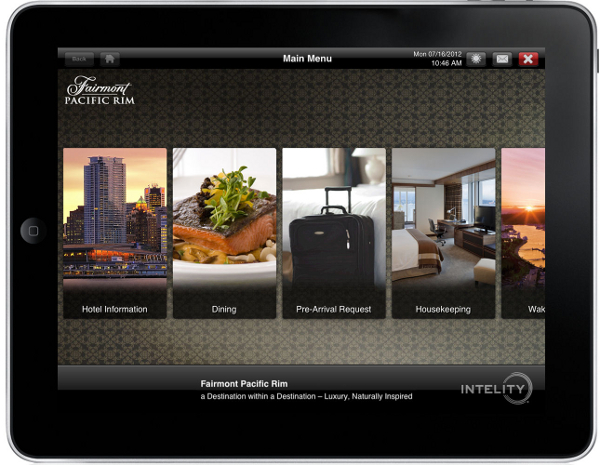Calling room service: could you please bring me a tablet
With the growing ubiquity of tablets, the check-in desk and the leather-bound printed hotel guide may soon be a thing of the past. Andrew Hennigan considers how the technology can improve customer service but also cut costs and drive new revenues streams for hotels.
Check in to some hotels today and instead of the usual printed hotel guide you will find an iPad in your room. With this you can order in-room dining, request housekeeping, check your bill, book spa services and sometimes even control the room lights. For consumers this service adds a new level of convenience; for hotel owners it probably brings more benefits than you might expect.
Unsurprisingly then, hotel software vendors are looking to extend their existing services to meet the demands of their hotel customers. Perhaps unsurprisingly there are a growing number of these. Blynk, Kieon, Protel and Intelity are among those vying for a share for what is undoubtedly going to become a busy marketplace. Intelity, which provides solutions to the likes of the Fairmont Pacific Rim in Vancouver and Four Seasons in Beverly Hills, has integrated its interactive customer experience (ICE) hotel management solutions with an iPad interface. “With the Intelity ICE Touch system, services are rendered more quickly and also more efficiently since the guest is connected directly with all departments,” says Phil Schwartz, Intelity’s Chief Marketing Officer.
Another big argument for replacing the traditional printed hotel guide with an iPad is that it gives hotels almost complete flexibility to change content. Anything from menus, operating hours, prices and so on can be changed with very little hassle. Eliminating the hard-copy hotel guide also reduces costs for printing. “This can be expensive if you are talking about colour reproduction and perfect binding,” he says. In fact by some estimates this can mean a saving of $300-$500 per room per year, to say nothing of the environmental message of a paperless solution.
In addition to cost savings, hotels also report an increase in revenue when they install digital guides. “Apple introduced the iPad in June 2010 and by September we were already delivering iPad solutions to our customers,” says Schwartz. As a result, over the last two years his customers have seen an average increase in room service orders of 18%.

Managing risk and driving new revenues
High-end hotels usually place an iPad in every room. Theft and damage are rare – just eight cases reported to Intelity in two years. “We lock down tablets so that they only work with hotel services,” says Schwartz, “plus guests are informed that if the iPad is lost or damaged the hotel will add $800 to the bill.” Less expensive properties are more likely to provide tablets in secure wall-mounted enclosures in public spaces. Many also offer an app that you can download to your own personal phone or tablet, using a hotel-provided code to access hotel services.
Early adopters are positive about their experience of using tablet solutions. “We have received very positive feedback from our guests”, says Philip M Barnes, general manager of the Fairmont Pacific Rim in Vancouver, a luxury hotel in Canada. “This technology has proved to be very popular with busy guests,” he says. More than half Fairmont’s guests use the iPads to request hotel services such as making housekeeping requests.
At the Four Seasons luxury hotel in Beverly Hills, Los Angeles they have also installed iPad devices in all 285 guestrooms. “This makes our hotel more appealing to a broader range of customers,” says General Manager Mehdi Eftekari. “We have also secured two viable revenue streams that solidify our decision to install this technology: we have engaged a company called OurStay to develop a shopping app within the hotel’s ICE system and we use the built-in banner ad feature of the ICE software to generate a solid stream of revenue for the hotel.”
It is this sort of lateral thinking that will help brands keep ahead of the pack. It is also important to understand the market you are operating in, who exactly your customer is and how they are using tablet devices. This way you can really give them what they want. For more detailed insights into consumer behavior in the US, France, UK, Germany and The Netherlands check out EyeforTravel’s recent consumer report.

